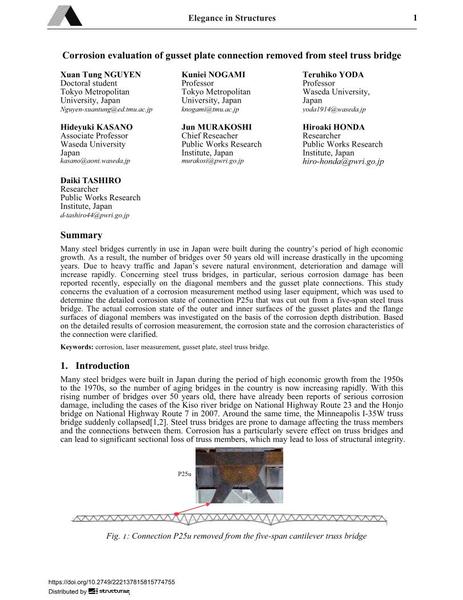Corrosion evaluation of gusset plate connection removed from steel truss bridge

|
|
|||||||||||
Détails bibliographiques
| Auteur(s): |
Xuan Tung Nguyen
Kuniei Nogami Teruhiko Yoda Hideyuki Kasano Jun Murakoshi Hiroaki Honda Daiki Tashiro |
||||
|---|---|---|---|---|---|
| Médium: | papier de conférence | ||||
| Langue(s): | anglais | ||||
| Conférence: | IABSE Conference: Elegance in structures, Nara, Japan, 13-15 May 2015 | ||||
| Publié dans: | IABSE Conference Nara 2015 | ||||
|
|||||
| Page(s): | 230-231 | ||||
| Nombre total de pages (du PDF): | 8 | ||||
| Année: | 2015 | ||||
| DOI: | 10.2749/222137815815774755 | ||||
| Abstrait: |
Many steel bridges currently in use in Japan were built during the country's period of high economic growth. As a result, the number of bridges over 50 years old will increase drastically in the upcoming years. Due to heavy traffic and Japan's severe natural environment, deterioration and damage will increase rapidly. Concerning steel truss bridges, in particular, serious corrosion damage has been reported recently, especially on the diagonal members and the gusset plate connections. This study concerns the evaluation of a corrosion measurement method using laser equipment, which was used to determine the detailed corrosion state of connection P25u that was cut out from a five-span steel truss bridge. The actual corrosion state of the outer and inner surfaces of the gusset plates and the flange surfaces of diagonal members was investigated on the basis of the corrosion depth distribution. Based on the detailed results of corrosion measurement, the corrosion state and the corrosion characteristics of the connection were clarified. |
||||
